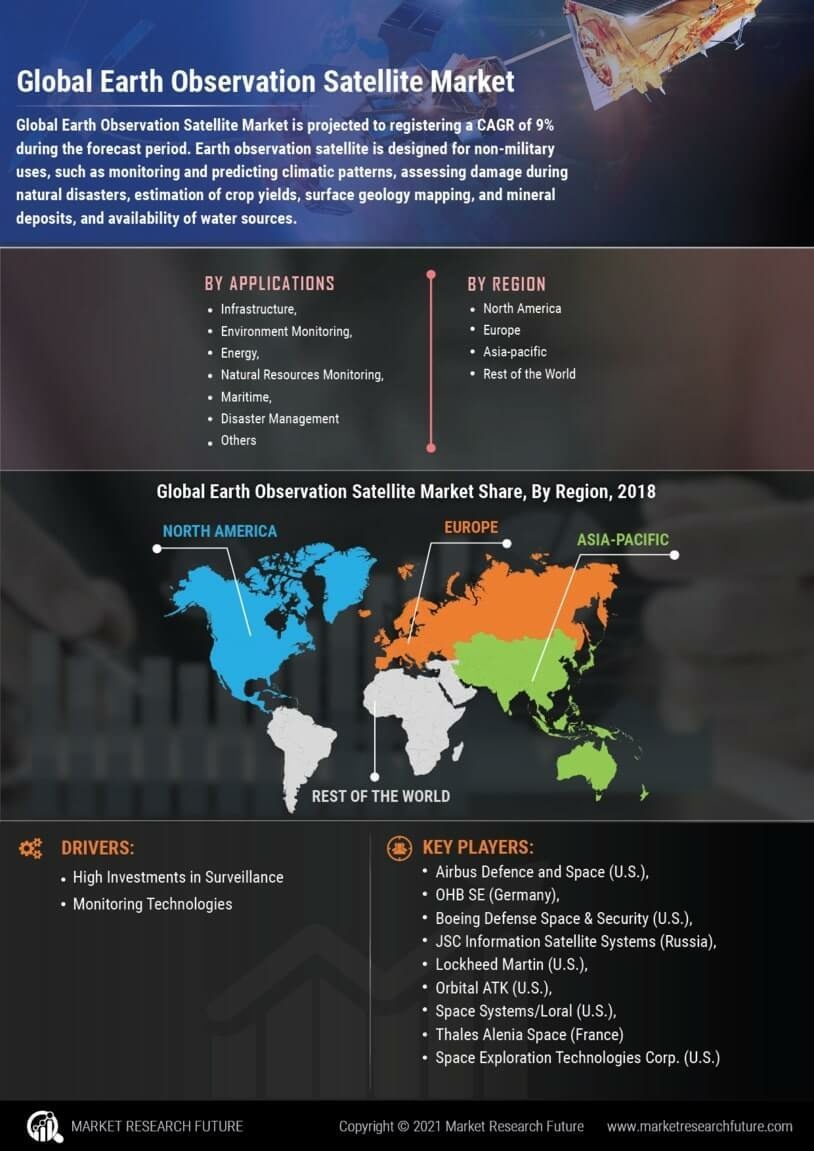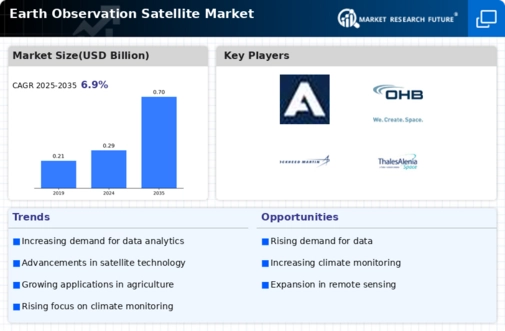Market Growth Projections
The Global Earth Observation Satellite Industry is projected to experience substantial growth over the next decade. With a market value of 0.29 USD Billion in 2024, it is anticipated to reach 0.7 USD Billion by 2035. This growth is underpinned by a compound annual growth rate (CAGR) of 8.21% from 2025 to 2035. Factors contributing to this expansion include increasing demand for satellite data across various sectors, advancements in technology, and heightened government support. The market's trajectory indicates a promising future, as stakeholders recognize the critical role of Earth observation satellites in addressing global challenges.
Government Initiatives and Funding
Government initiatives and funding significantly influence the Global Earth Observation Satellite Industry. Many countries are investing in satellite programs to enhance their capabilities in monitoring and managing natural resources. For instance, the United States government has allocated substantial budgets for NASA and NOAA satellite missions, which provide critical data for weather forecasting and climate research. These investments not only support national interests but also foster international collaboration in satellite data sharing. As a result, the market is expected to grow, with projections indicating a rise from 0.29 USD Billion in 2024 to 0.7 USD Billion by 2035, driven by increased government support and funding.
Growing Applications in Agriculture
The application of Earth observation satellites in agriculture is rapidly expanding, contributing to the growth of the Global Earth Observation Satellite Industry. Farmers and agronomists utilize satellite imagery for precision agriculture, enabling them to monitor crop health, optimize resource usage, and improve yields. For example, satellite data can help identify areas of drought or pest infestations, allowing for timely interventions. This trend is likely to continue, with the market projected to grow from 0.29 USD Billion in 2024 to 0.7 USD Billion by 2035, as more agricultural stakeholders recognize the benefits of satellite technology in enhancing food security and sustainability.
Advancements in Satellite Technology
Technological advancements play a pivotal role in shaping the Global Earth Observation Satellite Industry. Innovations in satellite design, miniaturization, and sensor technology enhance data collection capabilities. For example, the deployment of small satellites, or CubeSats, allows for more frequent and cost-effective data acquisition. These advancements not only improve the quality of data but also expand the range of applications, including agriculture, urban planning, and disaster management. As technology continues to evolve, the market is poised for growth, with an anticipated increase in market value from 0.29 USD Billion in 2024 to 0.7 USD Billion by 2035, reflecting the growing reliance on satellite data across various sectors.
Emerging Markets and Global Collaboration
Emerging markets are increasingly recognizing the value of Earth observation satellites, which is driving growth in the Global Earth Observation Satellite Industry. Countries in Asia, Africa, and South America are investing in satellite technology to address local challenges such as urbanization, resource management, and disaster response. Collaborative efforts, such as the Group on Earth Observations, facilitate data sharing and capacity building among nations. This trend suggests a robust growth trajectory, with the market expected to expand from 0.29 USD Billion in 2024 to 0.7 USD Billion by 2035, reflecting the global commitment to leveraging satellite data for sustainable development.
Increasing Demand for Environmental Monitoring
The Global Earth Observation Satellite Industry experiences a surge in demand for environmental monitoring solutions. Governments and organizations are increasingly utilizing satellite data to track climate change, deforestation, and natural disasters. For instance, the European Space Agency's Copernicus program provides critical data for monitoring land use and environmental changes. This heightened focus on sustainability and environmental protection is expected to drive the market's growth, with projections indicating a market value of 0.29 USD Billion in 2024, potentially reaching 0.7 USD Billion by 2035. The compound annual growth rate (CAGR) of 8.21% from 2025 to 2035 underscores the importance of satellite technology in addressing global environmental challenges.

















Leave a Comment